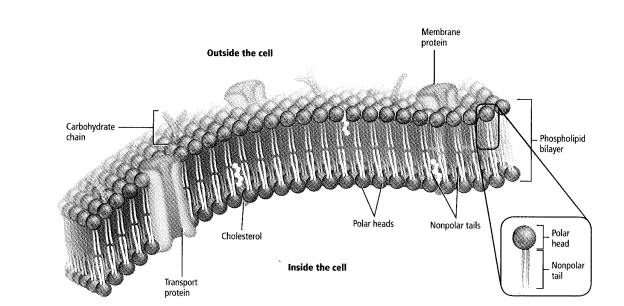
To describe:
The basic structure of plasma membrane
Introduction: All cells have a special membrane called plasma membrane that acts as a thin flexible boundary between a cell and its watery environment. It controls what enters and leave the cell. The cells of our skin and that of a plant stem, all have a plasma membrane. It also helps in maintaining homeostasis in an organism. Plasma membranes are selectively permeable as they allow only certain substances to pass through while keeping others out.All prokaryotes and eukaryotes have plasma membrane.
Answer to Problem 47A
Most of the molecules in the plasma membrane are made of lipids. A phospholipid is a molecule that has a glycerol backbone, two fatty acid chains and a phosphate group. The basic structural molecule of a plasma membrane is a phospholipid bilayer.
Explanation of Solution
The following diagram shows the structure of a plasma membrane.

The two layers of phospholipids are arranged tail- to- tail. Each phospholipid isrepresented as a head with two tails. The phosphate group makes the head polar. The polar head is attracted to water because water is also polar. The two fatty acids are nonpolar and are repelled by water. The phospholipids are arranged in such a way, that the polar heads are closest to water molecules. So the fatty acid tails form the interior of the plasma membrane and the heads face the watery environment found inside and outside the cell. This allows the plasma membrane to exist in a watery environment.
Along with phospholipids, there are other molecules like cholesterol, proteins and carbohydrates. Cholesterol molecules are nonpolar and are positioned among the phospholipids in such a way that they prevent the fatty acid tails of the phospholipid bilayer from sticking together. This causes fluidity in the plasma membrane.
Transport proteins help in transport of substances and waste materials through the plasma membrane.
The carbohydrates are attached to proteins and they define the cell’s characteristics and help cells identify chemical signals.
Chapter 9 Solutions
Glencoe Biology, Florida Edition
Additional Science Textbook Solutions
Campbell Biology (11th Edition)
Microbiology: An Introduction
Human Anatomy & Physiology (2nd Edition)
Chemistry: An Introduction to General, Organic, and Biological Chemistry (13th Edition)
Laboratory Experiments in Microbiology (12th Edition) (What's New in Microbiology)
College Physics: A Strategic Approach (3rd Edition)
- You have a stock vial of diligence 75mg in 3ml and need to draw up a dose of 50mg for your patient.how many mls should you draw up to give this dosearrow_forwardYou are recquired to administer 150mg hydrocortisone intravenously,how many mls should you give?(stock =hydrocortisone 100mg in 2mls)arrow_forwardIf someone was working with a 50 MBq F-18 source, what would be the internal and external dose consequences?arrow_forward
- We will be starting a group project next week where you and your group will research and ultimately present on a current research article related to the biology of a pathogen that infects humans. The article could be about the pathogen itself, the disease process related to the pathogen, the immune response to the pathogen, vaccines or treatments that affect the pathogen, or other biology-related study about the pathogen. I recommend that you choose a pathogen that is currently interesting to researchers, so that you will be able to find plenty of articles about it. Avoid choosing a historical disease that no longer circulates. List 3 possible pathogens or diseases that you might want to do for your group project.arrow_forwardnot use ai pleasearrow_forwardDNK dagi nukleotidlar va undan sintezlangan oqsildagi peptid boglar farqi 901 taga teng bo'lib undagi A jami H boglardan 6,5 marta kam bo'lsa DNK dagi jami H bog‘lar sonini topingarrow_forward
- One of the ways for a cell to generate ATP is through the oxidative phosphorylation. In oxidative phosphorylation 3 ATP are produced from every one NADH molecule. In respiration, every glucose molecule produces 10 NADH molecules. If a cell is growing on 5 glucose molecules, how much ATP can be produced using oxidative phosphorylation/aerobic respiration?arrow_forwardIf a cell is growing on 5 glucose molecules, how much ATP can be produced using oxidative phosphorylation/aerobic respiration?arrow_forwardHow do i know which way the arrows go?arrow_forward
 Human Anatomy & Physiology (11th Edition)BiologyISBN:9780134580999Author:Elaine N. Marieb, Katja N. HoehnPublisher:PEARSON
Human Anatomy & Physiology (11th Edition)BiologyISBN:9780134580999Author:Elaine N. Marieb, Katja N. HoehnPublisher:PEARSON Biology 2eBiologyISBN:9781947172517Author:Matthew Douglas, Jung Choi, Mary Ann ClarkPublisher:OpenStax
Biology 2eBiologyISBN:9781947172517Author:Matthew Douglas, Jung Choi, Mary Ann ClarkPublisher:OpenStax Anatomy & PhysiologyBiologyISBN:9781259398629Author:McKinley, Michael P., O'loughlin, Valerie Dean, Bidle, Theresa StouterPublisher:Mcgraw Hill Education,
Anatomy & PhysiologyBiologyISBN:9781259398629Author:McKinley, Michael P., O'loughlin, Valerie Dean, Bidle, Theresa StouterPublisher:Mcgraw Hill Education, Molecular Biology of the Cell (Sixth Edition)BiologyISBN:9780815344322Author:Bruce Alberts, Alexander D. Johnson, Julian Lewis, David Morgan, Martin Raff, Keith Roberts, Peter WalterPublisher:W. W. Norton & Company
Molecular Biology of the Cell (Sixth Edition)BiologyISBN:9780815344322Author:Bruce Alberts, Alexander D. Johnson, Julian Lewis, David Morgan, Martin Raff, Keith Roberts, Peter WalterPublisher:W. W. Norton & Company Laboratory Manual For Human Anatomy & PhysiologyBiologyISBN:9781260159363Author:Martin, Terry R., Prentice-craver, CynthiaPublisher:McGraw-Hill Publishing Co.
Laboratory Manual For Human Anatomy & PhysiologyBiologyISBN:9781260159363Author:Martin, Terry R., Prentice-craver, CynthiaPublisher:McGraw-Hill Publishing Co. Inquiry Into Life (16th Edition)BiologyISBN:9781260231700Author:Sylvia S. Mader, Michael WindelspechtPublisher:McGraw Hill Education
Inquiry Into Life (16th Edition)BiologyISBN:9781260231700Author:Sylvia S. Mader, Michael WindelspechtPublisher:McGraw Hill Education





